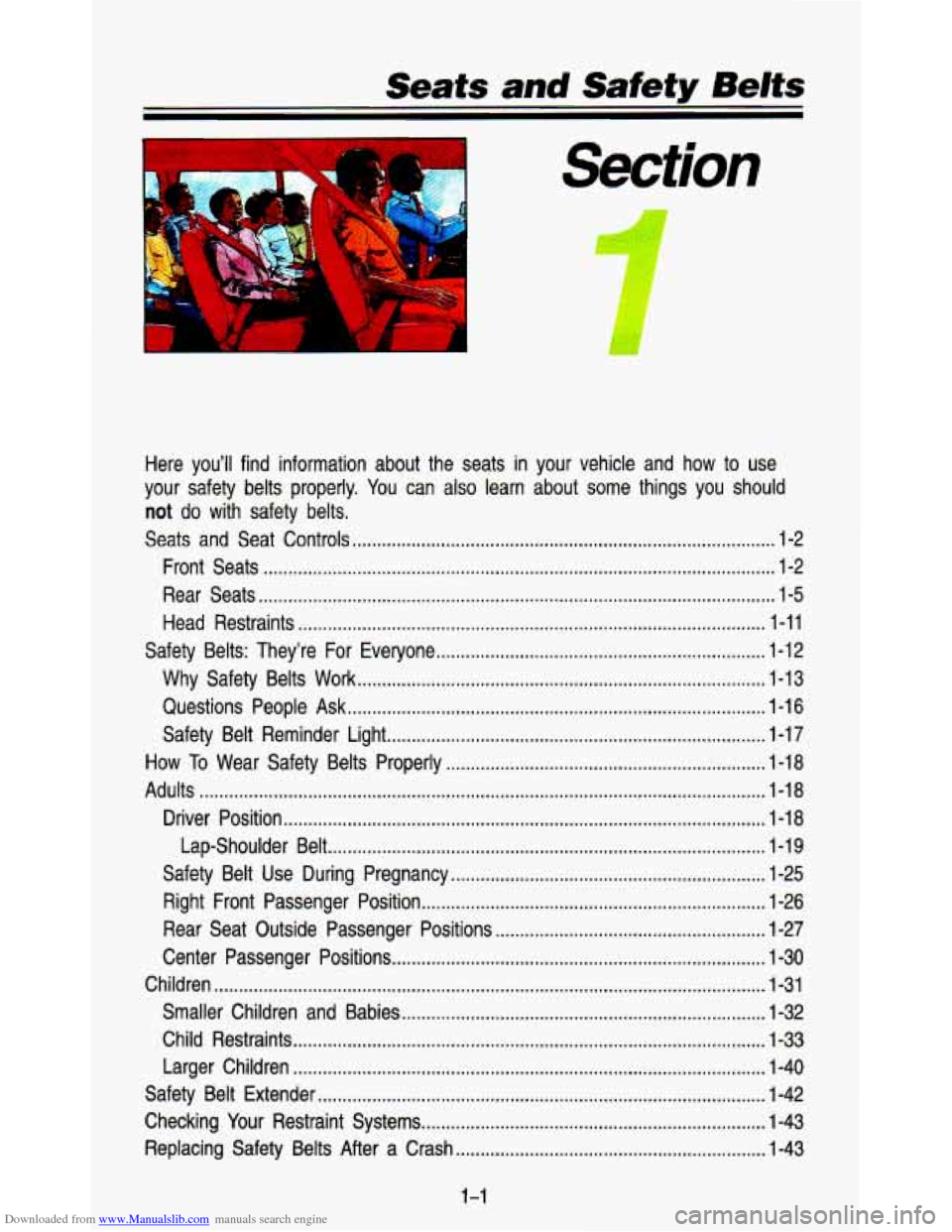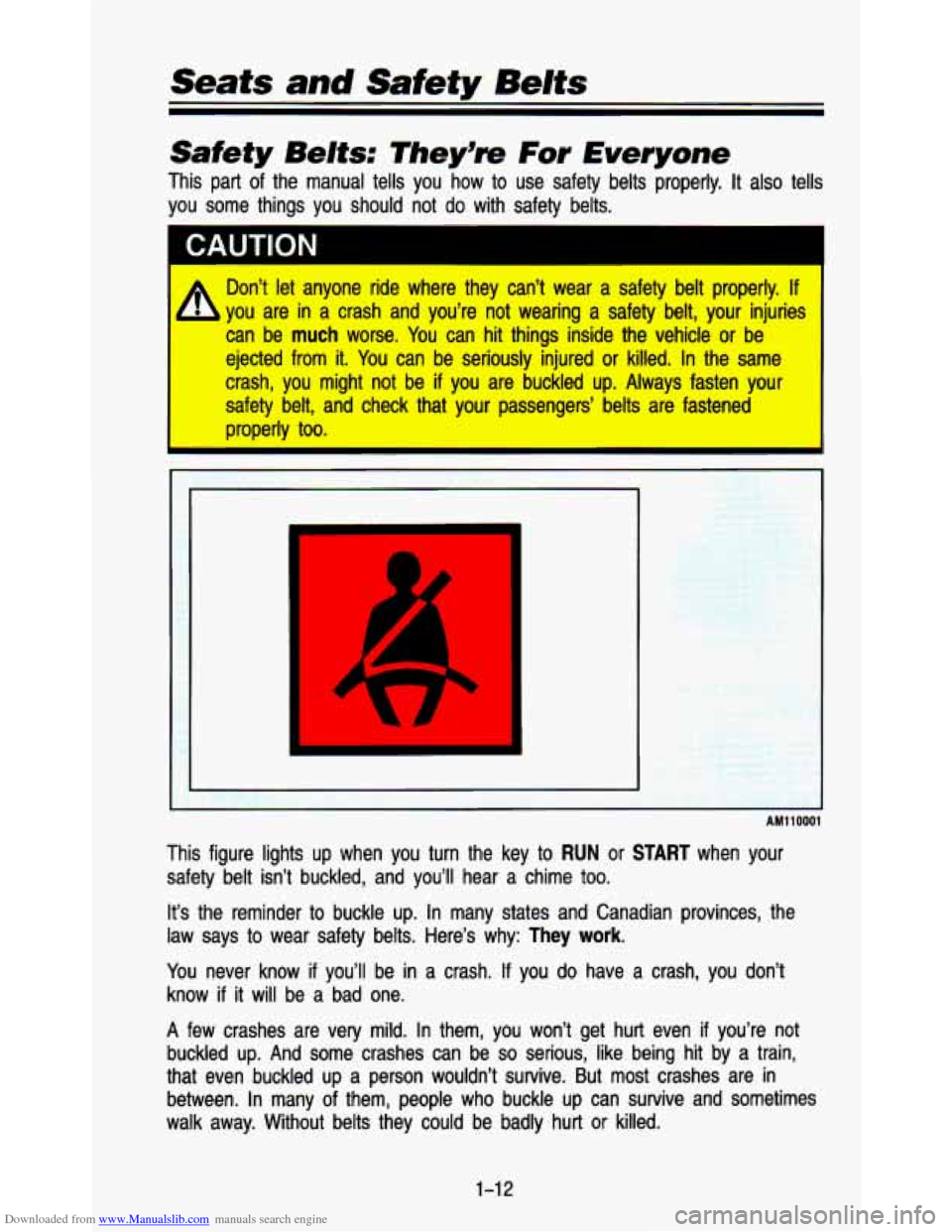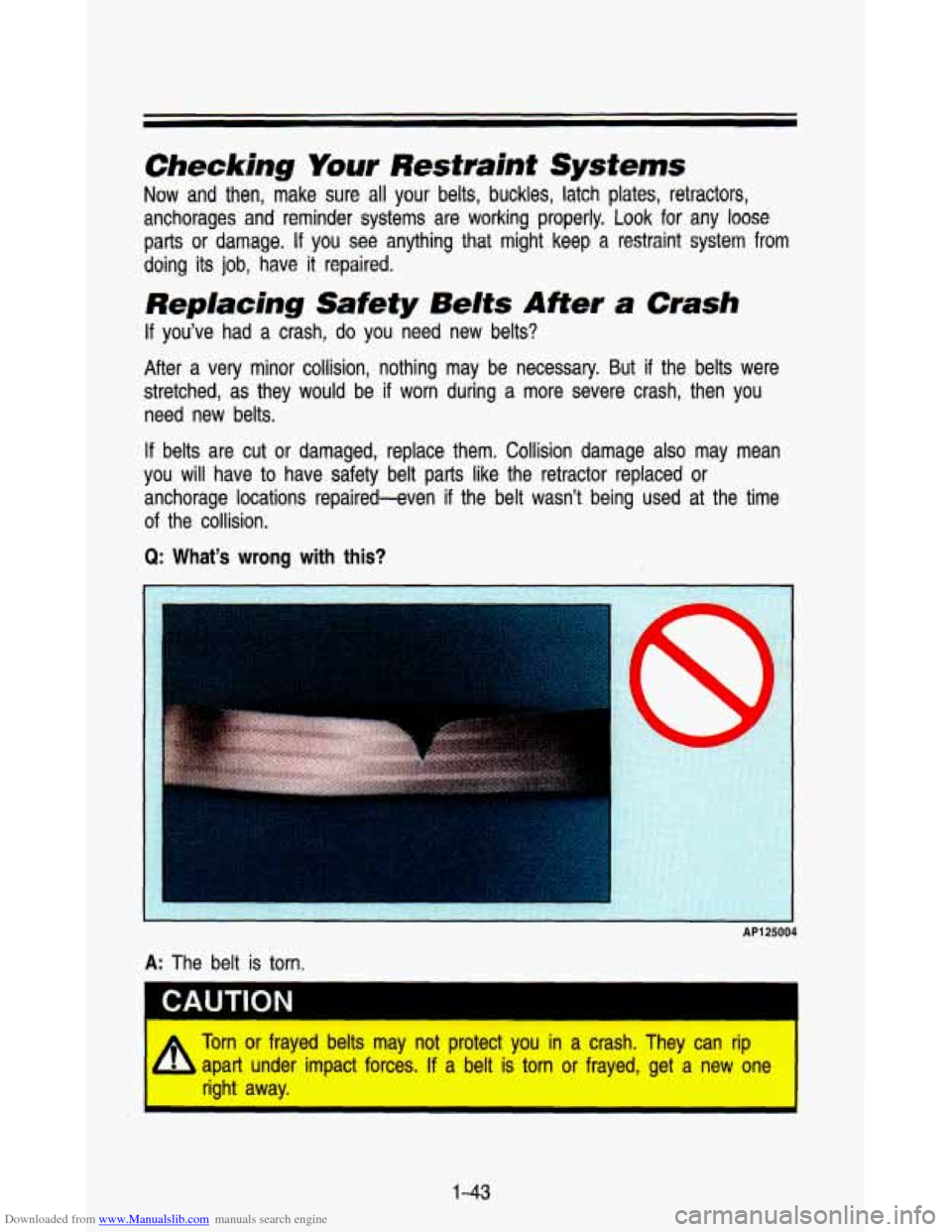1993 CHEVROLET ASTRO PASSENGER check engine
[x] Cancel search: check enginePage 13 of 345

Downloaded from www.Manualslib.com manuals search engine Here you’ll find information about the seats in your vehicle and how to use
your safety belts properly
. You can also learn about some things you should
not do with safety belts .
Seats and Seat Controls ........................................................................\
.............. 1-2
Front Seats
........................................................................\
................................ 1-2
Rear Seats
........................................................................\
................................. 1-5
Head Restraints
........................................................................\
....................... 1-11
Safety Belts: They’re For Everyone
................................................................... 1-12
Why Safety Belts Work
........................................................................\
........... 1-13
Questions People
Ask ........................................................................\
............. 1-16
Safety Belt Reminder Light
........................................................................\
..... 1-17
How To Wear Safety Belts Properly ................................................................. 1-18
Driver Position ........................................................................\
.......................... 1-18
Lap-Shoulder Belt
........................................................................\
................. 1-19
Safety Belt Use During Pregnancy
................................................................ 1-25
Right Front Passenger Position
...................................................................... 1-26
Rear Seat Outside Passenger Positions
....................................................... 1-27
Center Passenger Positions
........................................................................\
.... 1-30
Children
........................................................................\
........................................ 1-31
Smaller Children and Babies
........................................................................\
.. 1-32
Child Restraints
........................................................................\
........................ 1-33
Larger Children
........................................................................\
........................ 1-40
Safety Belt Extender
........................................................................\
................... 1-42
Checking Your Restraint Systems
...................................................................... 1-43
Replacing Safety Belts After a Crash
............................................................... 1-43
Adults
........................................................................\
........................................... 1-18
1-1
Page 24 of 345

Downloaded from www.Manualslib.com manuals search engine Seats and Safety Belts
Safety Belts: They’= For Everyone
This part of the manual tells you how to use safety belts pr\
operly. It also tells
you some things
you should not do with safety belts.
I
A Don’t let anyone ride where they can’t wear a safety bel\
t properly. If
- b you are in a crash and you’re not wearing a safety belt, your injuries\
can be
much worse. You can hit things inside the vehicle or be
ejected from it. You can be seriously injured or killed. In the same
crash, you might not be
if you are buckled up. Always fasten your
safety belt, and check that your passengers’ belts are faste\
ned
I properly too. I
I
I
AM110001
This figure lights up when you turn the key to RUN or START when your
safety belt isn’t buckled, and you’ll hear a chime too.
It’s the reminder
to buckle up. In many states and Canadian provinces, the
law says to wear safety belts. Here’s why:
They work.
You never know if you’ll be in a crash. If you do have a crash, you don’t
know
if it will be a bad one.
A few crashes are very mild. In them, you won’t get hurt eve\
n if you’re not
buckled up. And some crashes can be
so serious, like being hit by a train,
that even buckled up a person wouldn’t survive. But most cr\
ashes are in
between. In many
of them, people who buckle up can survive and sometimes
walk away. Without belts they could be badly hurt
or killed.
1-12
Page 55 of 345

Downloaded from www.Manualslib.com manuals search engine Checking Your Resfraint Systems
Now and then, make sure all your belts, buckles, latch plates, retractors,
anchorages and reminder systems are working properly.
Look for any loose
parts or damage.
If you see anything that might keep a restraint system from
doing
its job, have it repaired.
Replacing Safety Belts After a Crash
If you’ve had a crash, do you need new belts?
After a very minor collision, nothing may be necessary. But
if the belts were
stretched, as they would be
if worn during a more severe crash, then you
need new belts.
If belts are cut or damaged, replace them. Collision damage also may mean
you will have to have safety belt parts like the retractor replaced or
anchorage locations repaired-even
if the belt wasn’t being used at the time
of the collision.
Q: What’s wrong with this?
AP125004
A: The belt is torn.
CAUTION
Torn or frayed belts may not protect you in a crash. They can rip
apart under impact forces. If a belt
is torn or frayed, get a new one
right away.
I
1-43
Page 63 of 345

Downloaded from www.Manualslib.com manuals search engine PO412
To open the rear doors from the outside, open the right rear door fir\
st. Grasp
the handle
and pull the door open.
To open the left rear door, pull on the latch release handle in the inside of
the door.
To close the rear doors, close the left door first. Check to make sure both
doors are completely closed.
The rear doors have
a check assembly to keep the doors from opening
beyond
90".
2-7
Page 64 of 345

Downloaded from www.Manualslib.com manuals search engine To fully open the doors, push in on the clip and lift the check assembly up
off the mounting bracket. Do this on each door. Replace the assemblies the
same
way.
See the caution under “Swing-Out Windows” in this section.
i
Rear Hatch and Split-Panel Doors
e”,-”I .: i ‘r: r ,<“. *:, -..I c. . , 7 1
PO476
If you have this option, your vehicle must be in either P (Park) or N (Neutral)
to release the hatch and unlock the split-panel doors. If your battery is dead,
the hatch and doors will
not open, even from the outside with a key.
2-8
Page 65 of 345

Downloaded from www.Manualslib.com manuals search engine PO477
To release the hatch and unlock the split-panel doors from the inside of the
vehicle, press the hatch
switch on the instrument panel just left of the
steering column. Then, pull up on the hatch handle
and open .the doors.
To release the hatch and unlock the split-panel doors from the outside of the
vehicle, put the key in the lock and turn
to the right. Then, pull up on the
hatch and open the right rear door first. Grasp the handle an\
d pull the
door
open.
To open the left rear
door, pull on the latch release handle in the inside of
the door.
To close the rear doors, close the left door first. Check to make sure both
doors are completely closed.
The rear
doors have a check assembly to keep the doors from opening
beyond
90".
To fully open the doors, push in on the clip and lift the check assembly up
off the mounting bracket. Do this on each door. Replace the assemblies the
same way.
The hatch and split-panel
doors will automatically lock when the hatch is shut.
If the hatch is partially closed, the rear doors will lock and you will need to
use the key or "Hatch Rel." switch, located to the left of the steering column,
to unlock them. (See also Hatch Release Switch, Rear WiperNVasher,\
and
Rear Defogger in the Index.)
2-9
Page 86 of 345

Downloaded from www.Manualslib.com manuals search engine Features & Controls
Turn Signal and Lane Change hdicator
The turn signal has two upward (for Right) and two downward \
(for Left)
positions. These positions allow you to signal a turn or a la\
ne change.
To signal a turn, move the lever all the way up or down. When the turn is
finished, the lever will return automatically.
A green arrow on the instrument panel will flash in the direction of the turn
or lane change.
To signal a lane change, just raise or lower the lever until the green arrow
starts to flash.
Hold it there until you complete your lane change. The lever
will return by itself when you release it.
As you signal a turn or a lane change, if the arrows don't flash but just stay
on, a signal bulb may be burned out and other drivers won't see your turn
signal.
If a bulb is burned out, replace it to help avoid an accident. If the green
arrows don't go on at all when you signal a turn, check the \
fuse (see "Fuses" in the Index) and for burned-out bulbs.
If you have a trailer towing option with added wiring for the tr\
ailer lights, a
different turn signal flasher is used. With this flasher installed, the signal
indicator will flash even
if a turn signal bulb is burned out. Check the front
and rear turn signal lights regularly to make sure they are working.
2-30
Page 87 of 345

Downloaded from www.Manualslib.com manuals search engine Operation of Lights
Although your vehicle's lighting system (headlights, parking lig\
hts, fog lamps,
side marker lights and tail lights) meet all applicable Federal lighting
requirements, certain states and provinces may apply their own \
lighting
regulations that may require special attention before you operate these lights.
For example, some jurisdictions may require that you operate yo\
ur lower
beam lights with fog lamps at all times, or that headlights be turned on
whenever you must use your windshield wipers. In addition, most jurisdictions
prohibit driving solely with parking lights, especially at dawn or dusk.
It is
recommended that you check with your own state or provincial h\
ighway
authority for applicable lighting regulations.
Headlight High-Low Beam
I
PO433
To change the headlights from low beam to high or high to low, pull the turn
signal lever all the way toward you. Then release
it. When the high beams
are on, a blue light on the instrument panel also will be on\
.
2-31